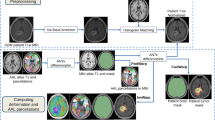Abstract
The purpose of our study was to examine the potential effects of conventional 3D based radiotherapy on functional MRI activation areas following the treatment of glioblastoma multiforme. Seventeen patients with a histologically proven glioblastoma multiforme were enrolled in this study. A functional MRI examination was performed alongside the planning CT and conventional MRI prior to the delivery of conventional 3D based radiotherapy. All patients received 3D based postoperative radiotherapy (up to 60 Gy) combined with temozolomide. Follow-up fMRI examinations were performed after completion of the treatment in the 6th week and in 3 months time. Changes of the task related activation areas were registered and analyzed. The difference in changes of high dose and low dose areas of the brain were also registered and analyzed. The comparison of the pretreatment and 6th week control fMRI activation areas revealed significant changes in motor activation and listening tasks in the case of brain areas which received a high dose (over 40 Gy). Based on the population level statistical parametric images (motor activation tasks) acquired at the 6th week control examination, a significant increase of signal was registered in the precuneus region and in the globus pallidus region. When comparing the 6th week and 3rd month activation signals, no significant changes were registered. Our results demonstrate the influence of radiotherapy on functional MRI signals within the human brain. Based on our findings, functional activation transfers from high dose areas to low dose areas. In case of the motor activation tasks, activations of the secondary motor area were observed following radiotherapy.



Similar content being viewed by others
References
Alvarez R, Liney G, Beavis A (2006) Repeatability of functional MRI for conformal avoidance radiotherapy planning. J Magn Reson Imaging 23:108–114
Aoyama H, Kamada K, Shirato H et al (2004) Integration of mfunctional brain information into stereotactic irradiation treatment planning using magnetoencephalography and magnetic resonance axonography. Int J Radiat Oncol Biol Phys 58:1177–1183
Burman C, Kutcher GJ, Emami B, Goitein M (1991) Fitting of tissue tolerance data to analytic function: improving the therapeutic ratio. Int J Radiat Oncol Biol Phys 21:123–135
Chang J, Kowalski A, Hou B, Narayana A (2008) Feasibility study of intensity-modulated radiotherapy (imrt) treatment planning using brain functional MRI. Med Dosim 33(1):42–47
Flickinger JC, Kondziolka D, Lunsford LD et al (2000) Development of a model to predict permanent symptomatic postradiosurgery. Int J Radiat Oncol Biol Phys 46:1143–1148
Friston KJ, Worsley KJ, Frackowiak RSJ et al (1994) Assessing the significance of focal activations using their spatial extent. Hum Brain Mapp 1:214–220
Garcia A, Liney G, Beavis A (2003) Use of functional magnetic resonance imaging in the treatment planning of intensity modulated radiotherapy. J Radiother Pract 3:63–69
Gore J (2003) Principles and practice of functional MRI of the human brain. J Clin Invest 112:4–9
Grabner G, Janke AL, Budge MM et al (2006) Symmetric atlasing and model based segmentation: an application to the hippocampus in older adults. Med Image Comput Comput Assist Interv 9:58–66
Jenkinson M, Smith S (2001) A global optimisation method for robust a_ne registration of brain images. Med Image Anal 5:143–156
Jenkinson M, Beckmann CF, Behrens TE et al (2012) FSL. Neuroimage 62:782–790
Jenkinson M, Bannister P, Brady M, Smith S (2002) Improved optimization for the robust and accurate linear registration and motion correction of brain images. Neuroimage 17:825–841
Kiebel SJ, Poline JB, Friston KJ et al (1999) Robust smoothness estimation in statistical parametric maps using standardized residuals from the general linear model. Neuroimage 10:756–766
Kovacs A, Toth L, Cs Glavak et al (2011) Integrating functional MRI information into radiotherapy planning of CNS tumors-early experiences. Pathol Oncol Res 17(2):207–217
Kovacs A, Toth L, Cs Glavak et al (2011) Integrating functional MRI information into conventional 3D radiotherapy planning of CNS tumors. Is it worth it? J Neurooncol 105(3):629–637
Liu WC, Schulder M, Narra V et al (2000) Functional magnetic resonance imaging aided radiation treatment planning. Med Phys 27:1563–1572
Marks JE et al (1980) Cerebral radionecrosis: incidence and risk in relation to dose, time fractionation and volume. Int J Radiat Oncol Biol Phys 7:243–252
Woolrich MW, Ripley BD, Brady M et al (2001) Temporal autocorrelation in univariate linear modeling of FMRI data. Neuroimage 14(6):1370–1386
Mirimanoff RO (2006) Radiotherapy and temozolomide for newly diagnosed glioblastoma: recursive partitioning analysis of the EORTC 26981/22981-NCIC CE3 phase III randomized trial. J Clin Oncol 24(16):2563–2569
Moonen CTW, Bandettini PA (eds) (1999) Functional MRI1. Springer, Berlin
Pantelis E, Papadakis N, Verigos K et al (2010) Integration of functional MRI and white matter tractography in stereotactic radiosurgery clinical practice. Int J Radiat Oncol Biol Phys 78:257–267
Smith SM (2002) Fast robust automated brain extraction. Hum Brain Mapp 17:143–155
Smith SM, Jenkinson M, Wooºlrich MW et al (2004) Advances in functional and structural MR image analysis and implementation as FSL. Neuroimage 23(Suppl1):S208–S219
Voges J, Treuer H, Sturm V et al (1996) Risk analysis of linear radiosurgery. Int J Radiat Oncol Biol Phys 36:1055–1063
Woolrich MW, Jbabdi S, Patenaude B et al (2009) Bayesian analysis of neuroimaging data in FSL. Neuroimage 45:173–186
Author information
Authors and Affiliations
Corresponding author
Ethics declarations
Conflict of interest
No conflict of interest declared.
Rights and permissions
About this article
Cite this article
Kovács, Á., Emri, M., Opposits, G. et al. Changes in functional MRI signals after 3D based radiotherapy of glioblastoma multiforme. J Neurooncol 125, 157–166 (2015). https://doi.org/10.1007/s11060-015-1882-2
Received:
Accepted:
Published:
Issue Date:
DOI: https://doi.org/10.1007/s11060-015-1882-2




